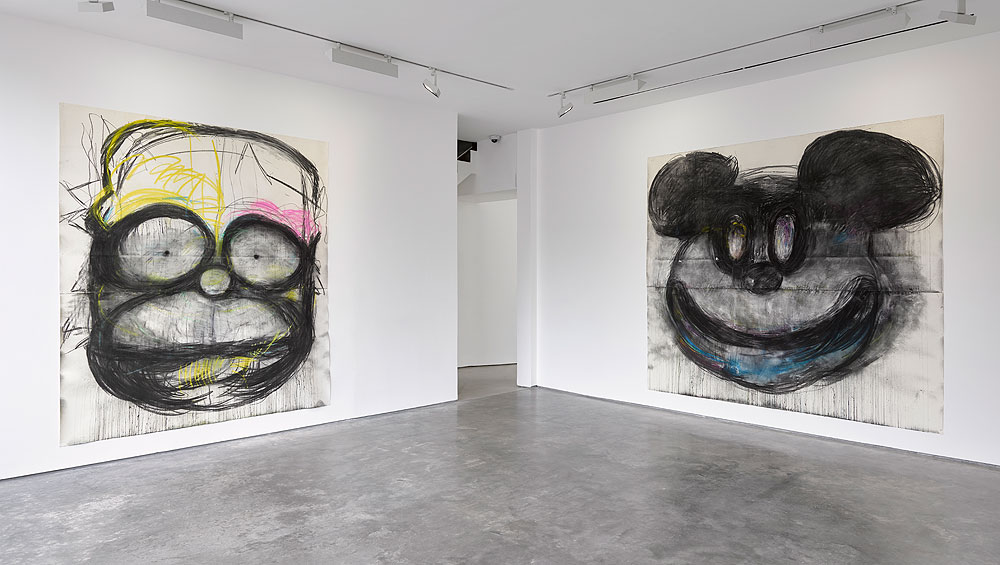
Lisson Gallery, London
19 May – 24 June 2017
by MATTHEW RUDMAN
The blank stare of a giant Homer Simpson; a gurning Mickey Mouse; a half-erased Batman cowl: this is the vocabulary of Joyce Pensato (b1941), the born-and-bred Brooklyn artist who for the past 30 years has been creating eerie and explosive large-scale portraits of cartoon characters and cultural icons, marrying pop art sensibilities with abstract expressionist-inspired execution. FORGETTABOUT IT, her second exhibition at the Lisson Gallery, is exclusively made up of Pensato’s 2017 output, revealing an artist still working intensively and experimenting with subtle shifts in her well-established style.
Pensato was a graduate of the New York Studio School of Drawing, Painting and Sculpture in the 1970s, where she was tutored by influential artists Mercedes Matter and Joan Mitchell. Pensato rebelled against the school’s strict focus on still life and figurative drawing, with discarded toys and comic books replacing apples and pears on her canvases. Throughout her career Pensato’s eye has been drawn to the cultural touchstones and abandoned ephemera of a quintessentially American childhood, and boasts an enormous collection of plush toys, models and statuettes of cartoon characters and mascots in her East Williamsburg studio.
Visible from the gallery entrance is FORGETABOUTITBATMAN, a huge painting of Batman’s cowl, the character’s eyes twisted into an almost gleeful expression. Elsewhere, a pair of warped Disney-style mice seem to waltz across the canvas, while, upstairs, Pensato has created a site-specific wallpaper for the exhibition, a photocollage featuring figures such as Lincoln and Robert De Niro, attacked with a storm of black, silver and gold paint. The reflective, trickling fluidity of these dramatic works, largely using enamel paint, are reminiscent of Pat Steir’s waterfall paintings, all bold horizontals drooling paint downwards in a chaotic, near-monochrome mix. These works are well-worn territory for Pensato: her muscular, assertive visual style betrays a strongly abstract expressionist sensibility, and the artist frequently cites Franz Kline and Willem de Kooning as key influences.
Other works on show see Pensato branching out, if only slightly, from her established style. Four Donalds 1-4 see Pensato forgo her typical black and silvery-white palette for a gaudy black-on-gold composition. The gold paint is laid on thickly, layer on layer compounded until the linen base resembles a melting metallic sheet. Pensato’s Donald Ducks, strangely compressed and reduced to their component geometries, rock back and forth, as if each painting is an extracted frame of an animated sequence.
Donald Duck is one of Pensato’s favourite subjects, as her sketches on show attest. Works such as her Let’s blow this joint series show Donald rushing to and fro, beak impossibly compressed, with wide anxious eyes and lines of movement pointing outwards in startled exclamation. Pensato recognises and revels in the sheer plasticity of cartoon characters, their ability to be diced, spliced and stretched in feats of death-defying adventure. Her paintings and drawings are often austere and ominous parallel versions of these characters, while in other works, such as The Erased Batman, Pensato literally peels back layers of paint to reveal a bare white expanse underneath. With her vigorous, attacking brushstrokes and sweeps of the eraser – The Eraser being one of the artist’s alter egos – Pensato probes the outer limits of what viewers will accept as figuration
Often thought of as a monochromatic artist, this exhibition sees colour returning to Pensato’s practice. On show in the front space of the gallery, prominently visible from street level, are three large charcoal and pastel drawings, each well over two metres across. Three of her favourite characters, Mickey Mouse, Homer Simpson and Donald Duck, are sporting bright shades of yellow, blue and magenta, as if lifted straight from an office printer. These lighter compositions do little to offset the unsettling nature of these crazed, vacant portraits, and the vicious scrawling patterns with which Pensato has applied her pigments rewards close observation.
Pensato is an artist of explosive energy, movement and tongue-in-cheek playfulness, and her work is reliably bracing. However, there is a challenge in putting on a solo exhibition of such work within a polite gallery space. Pensato has remarked on numerous occasions, most recently in the New York Times, how she has “always wanted to make art that trashed up a good white-cube gallery”. Her previous exhibition at Lisson Gallery, Joyceland, saw her recreate her chaotic Williamsburg studio and paint a large-scale Batman mural within the gallery. FORGETTABOUT IT, while showcasing an impressive range of engaging new material from Pensato, is lacking in such added personality, and can feel incongruously well-behaved by comparison.